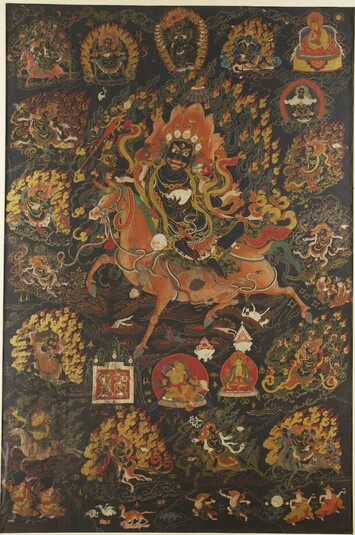
Item: Shri Devi (Buddhist Protector) - Magzor Gyalmo
| Origin Location | Tibet |
|---|---|
| Date Range | 1700 - 1799 |
| Lineages | Sakya and Buddhist |
| Material | Ground Mineral Pigment on Cotton |
| Collection | Tibet House, New York |
Shri Devi Magzor Gyalmo.
Shri Devi, Magzor Gyalmo (Tibetan: pal den lha mo, mag gyi zor le, gyal mo. English: Glorious Goddess, the Queen who Repels Armies, or the Queen who has the power to turn back armies. Sanskrit: Shri Devi, Yakshi Remati): belonging to the larger class of enlightened protector deities known as Shri Devi. Magzor Gyalmo is regarded as a wrathful emanation of the peaceful goddess Sarasvati, although popular in both Hinduism and Buddhism, the Buddhist deity is more properly known as Vajra Sarasvati and of a different entity and nature than the Hindu goddess Sarasvati. Within the Buddhist Tantric tradition Vajra Sarasavti is believed to be an enlightened deity while the Hindu form of the goddess is believed to be worldly in nature and not enlightened.
Among the many forms of Shri Devi, the specific form of Magzor Gyalmo, blue-black and wrathful, is recognized by having one face and two hands, holding aloft with the right hand a vajra tipped staff and in the left a skullcup held to the heart. She rides side-saddle atop a mule. Above her head is a large peacock feather parasol. In the Sakya and related Traditions there is a snake ornament for the right ear and a lion for the left. In the Gelug Tradition this is reversed and the lion is an ornament for the right and the snake for the left.
At the top center is the meditational deity Shri Hevajra. To the left is Panjarnata Mahakala and Shri Devi Dudsolma. To the right are Brahmanarupa Mahakala and a Tibetan Sakya Tradition teacher. Below the teacher is the female source for both Shri Devi and Mahakala - Ekajati.
Immediately to the right and left of the mule of Magzor Gyalmo are the two attendant deities - Makaramukha and Simhamukha. Separate from those last two attendant figures there are an additional five figures descending on the right and left. They are the Five Activity Protectors of Panjara Mahakala: Kala Rakshasa, Kala Rakshasi, Putra, Batra and Singmo.
At the lower center are the two skeleton protectors, Shri Shmashana Adhipati in a white skeleton palace, and the two wealth deities Yellow Jambhala and Yellow Vasudhara. Directly below are four figures atop four legged mounts. These female deities are the principal attendants for Magzor Gyalmo and represent the four seasons of the year: spring, summer, fall and winter. Outer attendant figures are depicted at very bottom of the composition in the forms of warriors, rakshasas, bhikshus (monks) and animals.
The textual source for Magzor Gyalmo is the Dakinyagnijihajvala Tantra, Dege Kanjur, volume 98, pp.223-253. It is found in the Nyingma Tantra section, vol.3. TBRC w22084.
Jeff Watt 5-2003 [updated 1-2014]
Front of Painting
English Translation of Inscription: [Inscriptions in Tibetan for each figure name]
Reverse of Painting
Special Features: (Printed script (Uchen))
Collection of Tibet House: New York (Repatriation)
Collection of Tibet House: New York (Painting Masterworks)
Buddhist Protector: Shri Devi, Magzor Gyalmo Main Page
Buddhist Protector: Shri Devi, Magzorma (Masterworks)

